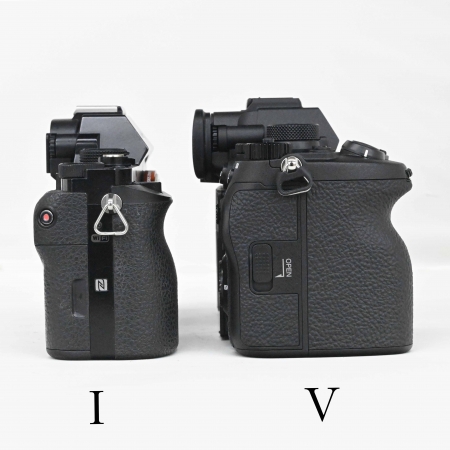Mirrorless cameras are getting... bigger?!
The selling point for mirrorless over DSLR was the size, so why are mirrorless cameras actually getting bigger?

We have been told for years that the main benefit of upgrading from a DSLR camera to a new mirrorless one is just how much size and weight you'll be saving. However, Champcamera has noticed that since the early days of mirrorless, these cameras are actually creeping back up in size.
While they are still a long way from being the same size as their DSLR predecessors, it is interesting to see that the small camera revolution seems to be falling back. Champcamera compared the original Sony A7 to the latest Sony A7R V. The a7 was announced in October 2013 and was one of the pioneering full-frame mirrorless cameras that started the whole movement into the mainstream. The Sony A7R V is the latest in this long line of best Sony cameras and was announced in October 2022. So there has been a nine-year gap between these two releases.
So let's compare the actual sizes of the two cameras, with the Sony a7 clocking in at 127x94x48mm, while the Sony A7R V measures up at 131x97x82mm. This means that the newer A7R V is about 1.8x bigger than the original a7.
In terms of weight, the original a7 weighs 474g, while the A7R V weighs a mighty 723g (both these weights include the battery). So again there is an increase of 1.5x increase in the weight of the Sony a7 mirrorless camera over various generations.
You may be thinking, these numbers don't sound all that bad. Camerachamp has provided some images below comparing the two cameras side by side, and the photos speak for themselves.




The full-frame game has stepped up a lot in recent years, with Sony, Canon, Nikon, and Panasonic coming out with their best mirrorless cameras in years. The Sony A7R V, Canon R3, and Nikon Z9 are duking it out to pack in the most technology possible into their bodies, a lot of this, such as complex 5-axis in-body stabilization is going to end up taking up more room than before, and leading to a larger camera.
The Sony a7 was one of the most cutting-edge cameras of its time. With a new 24-megapixel sensor, powered by the Bionz X processor, which allowed improved detail, lower noise, and reduced diffraction. It also had a cracking OLED electronic viewfinder, a 3-inch tilting LCD screen, Wi-Fi and NFC, and could record video in 1080p at 60fps.
The best camera deals, reviews, product advice, and unmissable photography news, direct to your inbox!
We have moved on a little since then. The A7R V serves up some massive 61-megapixel images, Bionz XR processing, and is backed up by the best image stabilization system ever in Sony cameras with effective 8-stop stabilization. You also get 8K video recording, as well as 4k 60fps movies, a max ISO of 102400, and a 4-axis variable-angle LCD screen.
Perhaps we're now so excited by features like in-body image stabilization, having the highest resolution and advanced video specs, we no longer mind if the best full-frame mirrorless cameras are starting to resemble the best DSLRs. If you're wondering what the real difference is, check out our guide on DSLR vs mirrorless cameras.

Gareth is a photographer based in London, working as a freelance photographer and videographer for the past several years, having the privilege to shoot for some household names. With work focusing on fashion, portrait and lifestyle content creation, he has developed a range of skills covering everything from editorial shoots to social media videos. Outside of work, he has a personal passion for travel and nature photography, with a devotion to sustainability and environmental causes.
